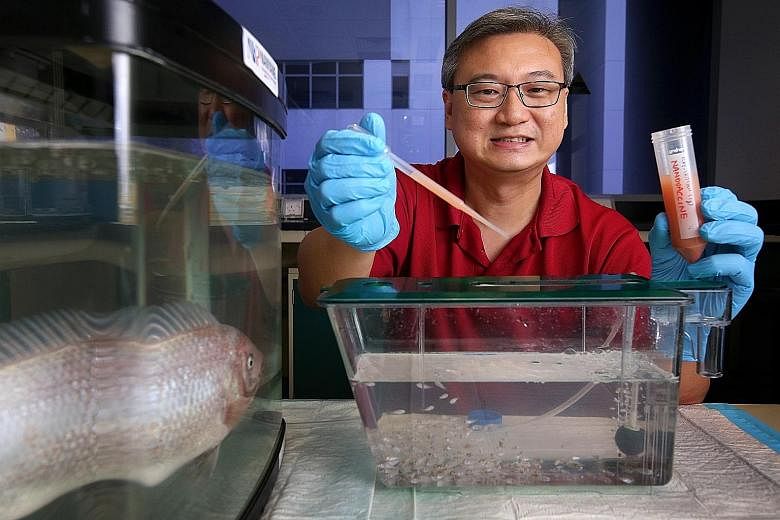The traditional way of protecting fish against disease is to inject them individually with a vaccine.
But this can be time-consuming and manpower-intensive.
Singapore researchers have come up with a way around this - using a tiny nano material.
They have found a way to package a vaccine for a common bacterium in tropical waters, tenacibaculum maritimum, into a material 100,000 times thinner than a strand of human hair. The bacterium causes the scales of infected fish to fall off and their mouths to disintegrate.
The new method will allow fish farmers to vaccinate their fish stocks by immersing them in a container of water containing the "nanovaccine". It then enters the fish through their gills and skin.
"There is no need for skilled workers, and fewer workers are needed... making it cheaper," said Dr Jeffrey Seng, a senior lecturer at Nanyang Polytechnic's School of Chemical and Life Sciences. He led the development of the nanovaccine.
With vaccination, fish do not need to be fed antibiotics when they are sick, reducing the chance of drug residues reaching humans.
But the injection method requires fish to be at least 10g. They also have to be immobilised using anaesthesia before trained workers can inject the vaccine at a precise location just below the belly. It takes one person about an hour to vaccinate 1,000 fish.
Dr Seng said the nanovaccine allows 60,000 or more fish to be vaccinated in the same amount of time, and the fish can be smaller.
While fish can already be vaccinated by being dipped into a container of the vaccine, this method is not as popular, as the protection is poorer and a much larger amount of vaccine is needed, Dr Seng said.
He added that the protection provided by the nanovaccine is on a par with that of the vaccine injection.
The team tested the nanovaccine on sea bass, and found that fish immersed in a solution with the nanovaccine had two times more antibodies than those immersed in the conventional vaccine solution.
The nanovaccine was developed over the past two years. The nano material used is a combination of clay and chitosan, derived from crustacean shells. Tests found that it did not affect the health of the fish and was not toxic to human colon cell lines. All traces of residue in the fish disappeared after a month.
Dr Diana Chee, deputy director of the Agri-Food and Veterinary Authority of Singapore's (AVA) aquaculture technology department, said manufacturers that intend to commercialise vaccines for local use must prove they are safe for fish and humans."Currently, there is overseas research into effective and safe nanovaccines for poultry, shrimp and fish. Similarly, there is potential for the development and use of nanovaccines for aquaculture in Singapore," she said.
There are other research groups coming up with easier ways to vaccinate fish, such as through a vaccine that can be mixed in fish feed, developed at Temasek Polytechnic (TP) with an Israeli partner.
Dr Padmanabhan Saravanan, head of the Centre of Innovation for Complementary Health Products at TP, acknowledged the benefits of nanovaccines.
But he said: "Because we have not fully understood the effects of nanotechnology, there is no firm evidence of how it will impact the food chain with humans at the top of it."
Dr Seng's team intends to register its nanovaccine with the AVA soon. There is currently no nanovaccine registered for use on food fish here.
Few of the 120 or so fish farms here vaccinate their fish because of a lack of expertise.Marine Life Aquaculture managing director Frank Tan said: "The current method is very tedious. We are excited by this nanovaccine research which, if successful, can be used to protect food fish from other bacteria strains more easily as well."
WATCH THE VIDEO
NYP researcher Jeffrey Seng explains how the new method works: http://str.sg/oZjh

